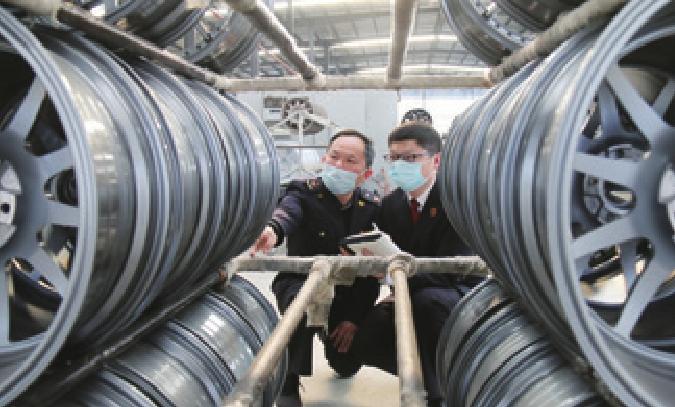POWER OF PATENTS
By Zhang Shasha


In a “cloud class,” students from a middle school in Tianjin Municipality were immersed in building their yellow ducks on April 24. With six sets of identical Lego blocks, the children created more than 20 kinds of ducks.
“Through the game, the class aspired to tell the students that it is important to respect creators and protect innovation, trying to enhance their awareness on intellectual property rights(IPR) protection,” Robin Smith, Vice President and General Counsel for LEGO China and Asia Pacific, told China Intellectual Property News. LEGO is one of the organizers of the activity.
Two days later, an online class was held to mark World Intellectual Property Day.
Such activities are regularly held at schools nowadays to spread intellectual property (IP) knowledge, and the youngsters appreciate the concept much more compared to their parents. “When I was young, watching pirated discs was normal, but I realized times had changed when my daughter said it was more than right to pay for songs,” Ma Yue, a 35-year-old mother engaged in the media and publishing industry, told Beijing Review. “And we became more cautious at work with copyrights for images and sounds; sometimes I have to ask my daughter to play the piano as the background music for my videos.”
While IPR protection has become the order of the day in China, the country has also expanded its presence in the overseas IP market. In 2019, China surpassed the U.S. as the top source of international patent applications filed via the World Intellectual Property Organizations(WIPO) Patent Cooperation Treaty (PCT) system, with 58,990 applications, a 200-fold increase in the past 20 years, according to a report of WIPO released on April 7. The news serves as a shot in the arm for Chinas efforts in IP development.
“The achievements can be mainly attributed to the implementation of innovation-driven development strategy and intellectual property strategy, enhanced innovation capacity and public awareness of IPR protection. Enterprises have also attached more importance to their IP development in overseas markets,” Shen Changyu, head of the National Intellectual Property Administration (NIPA), said at a press conference in Beijing on April 23.
Innovation stimulus
Themed Intellectual Property and Healthy China, this years National IP Publicity Week, held on April 20-26, highlighted the significant role IP has played in combating the novel coronavirus disease.
Thanks to a financing project of Shenzhen, Guangdong Province in south China, Liu Junfeng, Chairman of chemical company Lubair, received a 15-million-yuan ($2.13-million) loan on account of IP, which he called a timely help at a difficult time.
To help enterprises tide over difficulties, Shenzhen launched its first IP securitization project on March 25. Companies engaged in epidemic control can apply for low-cost loans with their IP as collateral. Lius Lubair was among the first 12 qualified companies, whose products, with independent IPR, are an essential ingredient of the state-designated disinfection products for the aviation industry.
“Compared with the traditional method of assessing companies value or the use of traditional collaterals, IP securitization provides convenience for knowledge-intensive enterprises in raising funds, which is an innovative development,” Liu said.
While being innovatively adopted in the financial sector, IP itself is closely related to innovation. Concerning the relationship between IP and innovation, Huang Weicai, CEO of Beijing MQPat Technologies Co. Ltd., an IP service provider, said, “IP is one of the most effective ways to protect and promote innovation.”
He told Beijing Review that IP enables innovators to promote their technologies and enjoy the resulting profits, thus serving as an umbrella for innovation and an amplifier for the value of innovation.
Zhao Lijian, a spokesperson for the Ministry of Foreign Affairs, said at a press conference on April 8 that “China has been vigorously raising public awareness of the notion that IPR protection is innovation protection.”
According to the 2019 edition of the Global Innovation Index report released by WIPO and other organizations, China has climbed from the 35th place in 2013 to the 14th in 2019, making it the top-ranking country among middle-income economies and one of the fastest growing countries worldwide. The past years have also seen China making strides in its IP development.
“Its a truly remarkable story,” Francis Gurry, Director General of WIPO, said on April 7, when talking about Chinas IP progress. The fast growth can be attributed to the governments strategy to treat innovation as its primary growth driver to promote high-quality development, he added.
China has been highlighting the role of IP and innovation in the modern economy and focuses on building IP systems, infrastructures, legislation, IP knowledge courses as well as specific IP courts, realizing that IPR protection is of high importance to increase its economic competitiveness, Gurry said, adding that Chinas experience and expertise can be shared with other countries.
Last year, the Intellectual Property Court of the Supreme Peoples Court was established to strengthen applicants confidence in rights protection in China. Patent examination has also become more efficient and more advanced in quality due to policy support, which includes reinforcing top-level design, improving laws and regulations, reforming institutions and mechanisms, and strengthening judicial and administrative protection.
Companies leading the pack such as Huawei and Oppo have also enhanced efforts on innovation, becoming the top PCT applicants. “It indicates that Chinas achievements in technological innovation are reflected more and more in the form of patents,” Wang Zhengzhi, senior partner with Globe-Law, a Beijing-based law firm, told Beijing Review.“China is moving forward toward an economy of higher value.”
Wang said an increasing number of companies are focusing on improving their IPR management systems since it is crucial for their sustainable development. Besides, with the commercialization of IP such as trademark licensing and patent transfer, many companies aware of the benefits of IP have already become unicorns. “When people say knowledge creates wealth, it is not just an empty talk,” he said. “There is a great potential for IPs marketoriented operation.”
Joint progress
Now, more and more companies are looking beyond the domestic market and filing for patents internationally, as its a key step for them to compete in overseas markets.

NR Electric Co. Ltd., a solution provider for power stability based in Nanjing, Jiangsu Province in east China, learned the drawback of not having patents overseas as it focused mainly on the domestic market before 2012.
“We participated in the bidding for a Canadian project, the owner clarified that the bidders should have patent portfolios in places where the project was carried out,” Zhao Xicai, deputy chief engineer of the company, recalled. He said without international patent registration, there is no chance to win bids for projects in developed countries. The experience forced the company to apply for international patents.
“IP is increasingly becoming the heart of global competition,” Gurry said. “Nevertheless, it is important to remember that innovation is not a zero-sum game.”
According to the WIPO report, the international patent applications filed via the PCT reached 265,800 in 2019, up 5.2 percent. “Last year was the best year we have experienced in the history of the organization,” Gurry said,“WIPOs IP services are successfully helping foster innovation and spread it worldwide.”

“A string of innovation enterprises were attracted to the Chinese market by its innovation climate. Corporate cooperation has stimulated intercity cooperation, which further promotes the global technological development and innovation cooperation,” Hanaut Bresson, General Manager of the European Financial Market Association in Paris, said.
Arduous task
Despite the breakthroughs China has made in its IP development, the country still faces shortcomings and challenges at this fledging stage.
“Large but not strong” is how Huang described the current status of Chinas innovation and IP standards. “Compared with developed countries such as the U.S., Japan and Germany, China lacks initial innovation capacity with lower output value of hi-tech and fewer core technologies,” he said.
Wang said although the research and development (R&D) spending has increased continuously, the funding for basic research is insufficient. In 2017, spending on basic research accounted for only 5.5 percent of the total R&D spending, which is far less than developed countries where the input ratio is 15-20 percent.
“The stumbling block for Chinas scientific development lies in core technologies and original skills, which is a bottleneck in the economys transition toward high-quality development,” Wang stated. Statistics show that 50-60 percent of the core technologies of China are derived from external sources while that of advanced countries is 30 percent. And 70 percent of technologies needed for a new product are imported and more than 80 percent of key parts and materials come from overseas.
In 2019, China recorded more than 180 billion yuan ($25.4 billion) of deficit in IP royalties, which brought huge pressure on the operation of companies like smartphone makers by eroding their profits.
Taking Xiaomi, a mobile phone manufacturer, as an example. Its spending on IP royalties accounted for 4 percent of its total revenue in 2017, more than its R&D spending and taking up one third of its net margin.
Huang said it is a pressing issue facing most of the phone manufacturers except Huawei. In 2016, Huangs company helped Meizu, a mobile phone manufacturer, turn the corner, after it was charged by a foreign IP giant that claimed huge royalties for 2,000 standard essential patents. With an independently developed software, MQPat excluded those patents that were not used by Meizu, bringing the final number far below the number listed in the complaint.
Although the payment was reduced, it reminded Huang that there is a big gap in terms of technology innovation and patent ownership between Chinese and foreign enterprises. So he made IP development a priority and tried to adopt new technologies such as artificial intelligence in his services.
He said expanding innovation expenditure is a must in the future as it is the foundation for high-value IP.
His views are echoed by Wang, who also suggested that the government further improve IPR protection legislation, expand basic research spending, and introduce financial capital in innovative activities.
Talking about challenges, Wang said a lack of dynamic mechanisms for the commercialization of scientific achievements has thwarted the countrys progress in scientific innovation. Incentivizing researchers should be a key goal of reform, in which companies and universities can play decisive roles and focus more on longterm benefits instead of short-term quantities and profits.

